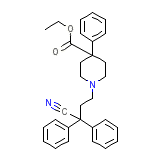Diphenoxylate




Categoria
Diphenoxylate Nombres de marca, Diphenoxylate Analogos
Diphenoxylate Marca los nombres de mezcla
Diphenoxylate Formula quimica
Diphenoxylate RX enlace
Diphenoxylate FDA hoja
Diphenoxylate MSDS (hoja de seguridad de materiales)
Diphenoxylate Sintesis de referencia
Diphenoxylate Peso molecular
Diphenoxylate Punto de fusion
Diphenoxylate H2O Solubilidad
Diphenoxylate Estado
Diphenoxylate LogP
Diphenoxylate Formas de dosificacion
Diphenoxylate Indicacion
Diphenoxylate Farmacologia
Diphenoxylate Absorcion
Diphenoxylate Toxicidad
Diphenoxylate Informacion de Pacientes
INFORM THE PATIENT (PARENT OR GUARDIAN) NOT TO EXCEED THE RECOMMENDED DOSAGE AND TO KEEP DIPHEN-OXYLATE HCL AND ATROPINE SULFATE OUT OF THE REACH OF CHILDREN AND IN A CHILD-RESISTANT CONTAINER, INFORM THE PATIENT OF THE CONSEQUENCES OF OVERDOSAGE, INCLUDING SEVERE RESPIRATORY DEPRESSION AND COMA, POSSIBLY LEADING TO PERMANENT BRAIN DAMAGE OR DEATH.
Diphenoxylate HCl and atropine sulfate may produce drowsiness or dizziness. The patient should be cautioned regarding activities requiring mental alertness, such as driving or operati ng dangerous machinery. Potentiation of the action of alcohol, barbiturates and tranquilizers with concomitant use of diphenoxylate HCl and atropine sulfate should be explained to the patient. The physician should also provide the patient with other information in this labeling, as appropriate.














